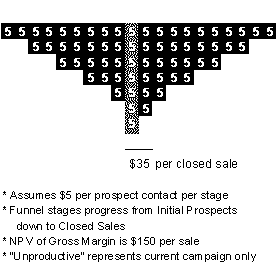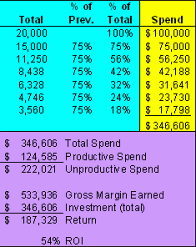In our first two articles, we established that the path to marketing profitability requires selecting tactics good enough to speed a buyer's progress and gaining an understanding of where prospects are leaking from the funnel. In this article, we concentrate on strategic approaches to managing this leakage to maximize marketing profitability, by concentrating effort where potential is greatest.
It's clear that unless you miraculously convert 100% of all prospects to sales, there will always be leakage from the funnel. Our objective in mapping the funnel and analyzing the leakage points is to establish the cost of this leakage and to select points in the funnel where performance improvements will result in the greatest additional profits.
So let's add marketing expense to the funnel analysis to understand both the investment and the return potential. The diagram and chart below show a prospect base of 20,000 that results in 3,560 (18% net sales rate) passing through the whole funnel. If we assume that the marketing and sales investments at each stage are $5 per prospect, we can see how much of the money spent at each stage is unproductive. To keep the analysis from being overly complicated, we'll take an isolated view of a single campaign and ignore its contribution to future campaigns.


Naturally, we cannot eliminate all unproductive spending. But we can understand where potential profit improvement is greatest. The proportion of spending that is unproductive can be quite extensive. In fact, had this scenario been run with a 2% net sales conversion rate, the unproductive spend would jump to $316,809 out of a total spend of $330,809.
Profitability improvements can be generated in four primary forms:
- Reduce leakage at those stages where improvement potential is greatest.
- Accelerate inevitable leakage to the earliest possible stage in the funnel to decrease unproductive spending.
- Focus on prospects that have most potential to progress through the entire funnel.
- Recycle leakage to bring prospects back into the funnel close to their stage of leakage.
Take-aways
- Cumulative prospecting investment increases with progression through each stage of the funnel.
- Conversion improvements in later stages of the funnel leverage the investments already made.
- Marketing ROI improvements are therefore highest when you either reduce leakage (and improve conversion) from the later stages in the funnel or increase leakage early in the funnel for those prospects least likely to convert to closed sales.
Reduce Leakage
Businesses that measure their ability to help buyers to progress between stages often learn that their ability to help buyers to progress is better than they thought in some places and worse in others. Effective measurement of late-funnel stages requires careful codification of the sales recording systems around buyer progression (not sales activity).
Early funnel stages can be measured easily if the tactics are interactive (Web, email, online surveys); if the tactics are not interactive, then spot surveys or polling may be required.
Our experience suggests that just as measurement paints a different picture from what might be expected, comparison paints a different picture again. Companies brave enough to compare their effectiveness at causing progression (stage by stage) against the effectiveness of others learn another valuable lesson.
Both can focus our attention on where leakage must be plugged for high potential buyers and accelerated for low potential buyers.
Let's reintroduce the progression matrix from part 2 of the article series to illustrate this important point. However, as we are now focused on reducing leakage, let's display leakage rates rather than progression rates (leakage of 25% is the same as progression of 75%).
Stage in Journey | Target Leakage | Measured Leakage | Gap Versus Target | Benchmark Leakage | Gap Versus Benchmark |
| Become troubled | 25% | 30% | 20% | 20% | 33% |
| Acknowledge a need | 25% | 25% | 0% | 15% | 40% |
| Identify options | 25% | 50% | 100% | 50% | 0% |
| Identify payback | 25% | 20% | -20% | 20% | 0% |
| Select preferred option | 25% | 25% | 0% | 50% | -100% |
| Justify/gain agreement | 25% | 50% | 100% | 40% | 20% |
| Buy | 25% | 30% | 20% | 25% | 17% |
In this example, a measured leakage rate of 50% in the stage called “Identify Options” indicates a gap in the measured performance of 100% against target. The performance gap for the stage we called “Justify/gain agreement” is likewise 100% and obviously worthy of attention.
When the measured performance is compared against similar businesses, however, it becomes clear that the first two stages (“Become troubled” and “Acknowledge a need”) are also worthy of attention. Other businesses have proven that great gains are possible in these two stages.
Our approach to improve the first two stages of the funnel, where we are performing below benchmark levels, is to reduce the number of prospects entering the funnel. Profiling prospects that leak can guide the shift in targeting. For the “Identify options” stage, we must focus on capturing intelligence early in the marketing dialogue to remove unqualified prospects or better identify needs that can improve conversion in this stage.
For the performance gap in the “Justify/gain agreement” stage, our focus must be on improving conversion. Here we have a problem getting management support after being selected as the preferred option by those responsible for screening and recommending a solution. We must look for marketing and sales tactics that appeal to senior management such as case studies, reference accounts or an ROI analysis.
Take-aways
- Compare target leakage to actual leakage to identify performance gaps.
- Compare your actual leakage to benchmarks to identify improvement potential.
- Prioritize where leakage can profitably be plugged or accelerated.
Accelerate leakage
We explained in part 2 of this four-part series why the time taken to progress through each stage (which we refer to as “lag”) is just as important as leakage.
We have found that salespeople often keep potential opportunities on their forecast long after they should have been removed. One company using Funnel Logic™ has found that in its case it takes three times as long to lose an opportunity as to win one.
In other words, if a buyer appears to have stalled at a stage longer than usual, it is common that this buyer will never progress. Naturally, there are exceptions, but buyers stalled on their journey should be scrutinized carefully.
So why not just leave them in the funnel? Because you have scarce resources in Sales and Marketing, and any time spent on buyers that have stalled terminally uses up precious cycles that are not being spent on buyers more ready to progress.
This scrutiny will suggest that once the “normal” rates of lag are understood, some of the buyers that have stalled should be forcibly removed from the clutches of the salesperson. This is only practical when robust recycling programs (see later) are available to nurture these stalled prospects until they are ready to be handed back to Sales for progression. Marketing is often better equipped to cost-effectively perform this nurturing role than Sales.
Clearly, this handover and hand-back process needs loads of trust between Sales and Marketing to work, but freeing Sales resources to operate on “progression-ready” buyers is a proven way to liberate significant profits.
We explain in “Recycle Leakage” below one of the important process changes necessary to support this accelerated leakage. Salespeople are naturally disinclined to let go of prospects that they've invested in, even if logic suggests this path.
As a result, it's important to have smooth processes that allow value to be added, visibility for the salesperson at all times, and for warm prospects to returned to the same sales person once they've become more sales-ready.
The other change necessary to support accelerated leakage is increased lead-flow. If we ask a salesperson to release a stalled prospect that they've worked hard to progress, we had better have more qualified leads to give him/her for progression in return.
Take-aways
- Prospects that show extended lag time in progressing through the funnel must be removed from the standard sales efforts and treated with nurturing initiatives that can sustain their position in the funnel until progression can be restored.
- Sales and Marketing must partner to leverage their strengths and maximize the ROI that results from effective funnel management.
- Demand-generation programs must be well in place to allow accelerated leakage to be replaced with new prospects.
Focus on the Right Prospects
Having the right prospects in the funnel in the first pace is a matter of strategy, whereas all the other changes discussed in this article are about planning optimized tactics. We'll therefore deal with this in part 4 of this article series.
Recycle Leakage
The majority of prospects that enter the funnel will leak, yet the efforts of Marketing and Sales are applied almost exclusively to the declining percentage still in the funnel at any point in time.
Yes, we cannot lose sight of the fact that there is nothing more important than continuing the progression for prospects moving through each stage of the sales cycle. However, the success we've achieved with prospects moving partially through the sales cycle is often completely abandoned when the marketing and sales cycle starts over again and again.
While we are making improvements in reducing the leakage, we should also look for opportunities with those buyers who have leaked. For how long should leaked buyers be left alone before they are returned to the funnel? To what stage should they be returned? Will the answers differ depending on which stage they leaked from? What should we do to them whilst they are out of the funnel?
For example, if 20% of our buyers failed to identify a payback, we might decide to leave them alone for two quarters before attempting to recycle them to the “Acknowledge a need” stage. We may find that their pain points shift over time and our message may suddenly gain interest.
To optimize our probability of success in this recycling endeavor, we might send monthly white papers and case studies supporting the business case that our solution addresses (but not discuss the solution itself because they are yet to acknowledge a need for such a solution).
Prospects that leak toward the latter stages could, for example, be segmented based on [1] their need for our solution (still exists, no longer exists, or could be revived if competitor solution fails) and [2] their reasons for leaking (chose a competitor, postponed the purchase, or did not match with our solution).
In addition to creating the plan for recycling those prospects that qualify as having high potential and value, we should also determine how our strategies and tactics can better disqualify and screen out those most likely to leak.
Take-aways
- Qualify leaked buyers to determine who should be recycled.
- Identify the recycling path for leakage from each stage, including how long you'll “allow” them to stay leaked before you attempt to recycle them.
Knowing where to concentrate your efforts on reducing leakage at each stage in the buying cycle is critical for marketing profitability. Accelerating low-potential prospects out of the funnel early can save significant financial and staff resources.
Analysis and benchmarking progression through the funnel will guide you toward the greatest potential for success. And putting efforts toward recycling qualified prospects that leak from the funnel offers the opportunity to convert previous investments and success into financial returns.
In the final article of this series, we will provide additional strategies and marketing ROI principles to build on the insight gained from mapping the buyer's cycle and managing the sales and marketing funnel.




